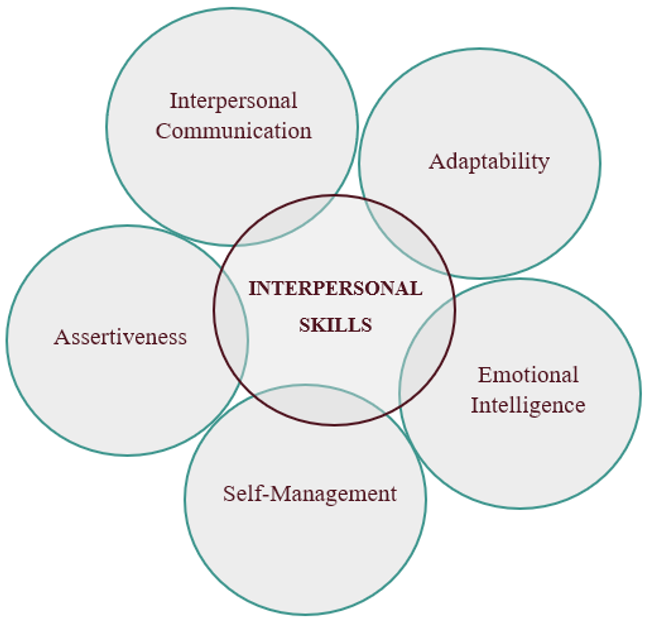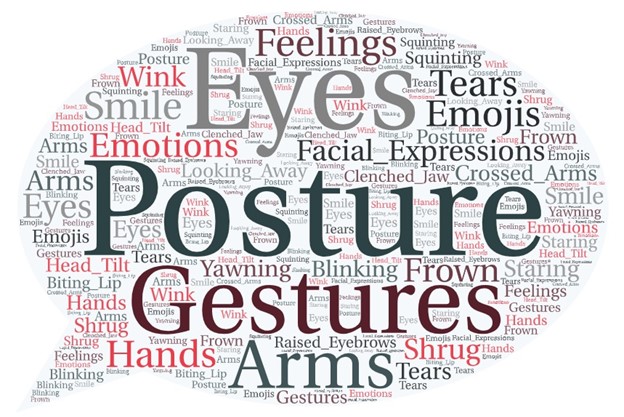Chapter 8: Interpersonal Skills
8.1 What Are Interpersonal Skills?
Have you ever heard of the term “people skills”? If you are a person, does that mean you have people skills? How can someone have, or not have, people skills? People skills, or interpersonal skills, are the techniques and behaviours you use when you are working with other people. We are using the term interpersonal skills in this chapter to explain a bit about what we mean by people skills. Inter means between or among, so interpersonal skills are the skills you use between and among other people.
Interpersonal skills are the basis of relationships and involve how you interact with, adjust for, and consider others. In other words, these are the skills you need to succeed when you are working with other people, including when you are collaborating with others, dealing with difficult situations, listening, and expressing yourself. Individuals who regularly practice interpersonal skills become adept at speaking openly, being appropriately assertive, reading body language cues, practicing humility, and empathizing with others.
You will learn and adopt people skills as natural qualities throughout your life. As you reflect upon yourself, your goals, and your skills, you will identify areas for growth, and then be able to develop and expand on these skills intentionally. Poorly developed interpersonal skills can negatively impact your ability to build relationships, adapt to new circumstances and change, and be perceived as insincere in your interactions.
Activity
Use the following interactive activity to explore some examples of interpersonal skills.
 Interpersonal Skills
Interpersonal Skills
- Interpersonal Communication: Includes listening skills, our abilities and skills to interact with others, how we flow thoughts and ideas to others, how information is received, reading body language cues, making eye contact, our facial expressions, empathy, conflict resolution, and teamwork.
- Adaptability: This is how we adjust to change, how we transition during change, working in uncertainty, being solution-minded, having a willingness to learn, and seeking information.
- Emotional Intelligence (EI): EI is understanding and managing our own emotions in responses, recognizing the emotions of those around us, self-awareness, social awareness, responding to the situational environment, coping with pressure, dealing with stress, having empathy, and practicing patience.
- Self-Management: Includes setting goals, continuous learning, seeking responsibility, being responsive, productive, accountable, punctual, and dependable.
- Assertiveness: Is the ability to successfully communicate thoughts and ideas, be open to feedback, respectfully communicate opposing thoughts and ideas, defend your views calmly and politely, negotiate rather than passively agree, and have self confidence.
Reflect on Interpersonal Skills
Taking time to reflect on your interpersonal skills is an important way you can work toward professional growth. There are many resources available through workshops, online, and in print that you can engage in as you try looking to better understand and expand your interpersonal skills. To start, try using the interpersonal skills assessment with Skills You Need. Their free assessment investigates the interpersonal skills listening, communicating, emotional intelligence, and group work.
What did you think of your assessment results? Consider spending some time reflecting (see 1.3 Reflective Practice in WIL) on your responses, results, and how you would like to move forward with interpersonal skills in your professional practices. As you reflect, ask yourself:
- Which skills should I focus on improving?
- How accurate am I in assessing my own strengths and weaknesses?
- Are there skills where I have overvalued my own skills compared to others?
How is Interpersonal Communication Different From Effective Communication?
Interpersonal and effective communication go hand and hand and are often mistaken for the other. The difference in interpersonal and communications skills comes down to context versus content. Interpersonal skills are the ways you create the context for communication, including the way you engage with others and build relationships. Effective communication, as we see in Chapter 9, is about the content of what you say, how clear it is, and how easy it is for your audience to understand. In other words, interpersonal communication includes your behaviours and abilities to interact with other people , while effective communication is how you convey information in a comprehensible way while taking into account your audience and how your information may be received (McPheat, 2019). Interpersonal communication reflects emotions, thoughts, ideas, and empathy in our approach and responses, while effective communication reflects the types of communication styles and how to best reach the listeners and reciprocate what is being heard.
What goes into communication that isn’t words? Take a moment to brainstorm. Here are some ideas that you may have thought of.
- How we stand or sit
- Posture
- Arm placement
- Where and how we move our eyes
- Our facial expressions
- Our feelings toward the people
- How we are using technology
- Emojis
- Hand gestures

Interpersonal communication relies on gestures, body language, and on the needs, motivations, and goals of each participant in the interaction. This means interpersonal skills are is also about feelings and behaviours. Beyond just the sharing of information, William Schutz (1966, as cited by DiCioccio, Rubin, Westmyer, 1998), expressed that interpersonal communication helps us to achieve connection with others including feelings and behaviours that promote inclusion, control, and affection.
The Fundamental Interpersonal Relations Orientation (FIRO) theory developed by Schutz conceives that:
- Beliefs of self drives feelings
- Feelings drive behaviour
- Behaviour drives results

Schutz’s theory also suggests that successful relationships are based on understanding and managing self-esteem, valuing and respecting others, and adjusting your styles as needed to either support yourself or accommodate others (Blackman, n.d.).
Learn more about FIRO theory with the following video: Fundamental Interpersonal Relations Orientation (FIRO)
Interpersonal communication requires you to pay attention to how others perceive you. You need to do three things at once:
- Pay attention to the words you are using and how they might be interpreted.
- Pay attention to your non-verbal signals and body language and how they might be interpreted.
- Listen carefully to your communication partner(s). Interpret their words and non-verbal signals.
Case Study: Pat Responds to a Bad Communication Context
Pat has now been in her work placement for two weeks, and it is just like Sandra described! She is busy and spends a lot of time engaged in meetings and group discussions. She is learning a great deal through the people and tasks assigned to her. However, she has a big problem. She is worried that the counsellors she is working with are mad at her. She has been having trouble with meetings at the beginning of the day. Most days, the programming doesn’t begin until 11am, so the team uses the first part of the day for planning and collaborating. Pat has been late for two separate team meetings because she has missed her bus connection. Both times, it wasn’t her fault because the bus was behind schedule. The first time the team was very forgiving and Sandra didn’t prompt for a reason. This morning was the second time and some of the team members now seem frustrated with having to wait to get started with the meeting. Pat looks around the room. No one is saying anything, but the room feels tense. One counsellor has his arms crossed, and another lets out a huge sigh. Sandra keeps looking at her watch. Pat knows her behaviour may have contributed to this context, and that she should address it. She does her best to remain positive and prepares to speak. She comes up with a plan:
- Apologize for being late. This will show respect.
- Acknowledge that my lateness impacts that group. This will show empathy and help acknowledge the group feelings.
- Suggest they start without me in the future. This will help solve the problem more effectively if it happens again. Since I can’t control the bus, it could happen!
- Explain the reason for my lateness and a plan to change it. I can take an earlier bus. This provides context and shows a willingness to respond to the needs of the group.
- Ask if there is anything else I can to do. Since I don’t know all of the factors shaping people’s behaviour towards me, and I am still getting to know everyone, it is worth it to check. and
- If she explains herself, maybe she can reset the context and help encourage everyone to focus on participation in the meeting discussion.
Media Attributions
- “Interpersonal skills” by Melissa Fournier is licensed under a CC BY-NC 4.0 licence.
- “Figure 8.1 Word Cloud of Non-Verbal Communication” by Deb Nielsen, Emily Ballantyne, Faatimah Murad and Melissa Fournier is licensed under a CC BY-NC 4.0 licence.
- Figure 8.2 Fundamental Interpersonal Relations Orientation (FIRO) theory by Deb Nielsen, Emily Ballantyne, Faatimah Murad and Melissa Fournier, adapted from Blackman, n.d., p.1, is licensed under a CC BY-NC 4.0 licence.
- “Fundamental Interpersonal Relations Orientation (FIRO)” by The Myers-Briggs Company is licensed under a Standard YouTube License.

